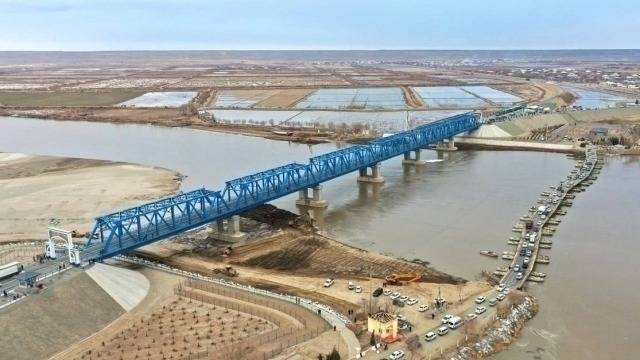
Amudarya District is a district of the Republic of Karakalpakstan. It was established on December 18, 1957. Amudarya District borders Nukus District to the north, Gurlan District of Khorezm Region to the east, Gubadog District of Turkmenistan to the south and west, and Dashoguz District of Turkmenistan to the south. The area is 1.02 thousand km². The population is more than 204.7 thousand people (2020). Amudarya District has 1 city (Mangʻit), 2 towns (Jumurtov and Kipchak), and 10 aul citizens' gatherings (Bobur, Dorʻmon, Kuyuqkoʻpir, Nazarkhan, Chin, Choykul, Orta-kalʻa, Qilichboy, Kipchak, Kholimbeg). The center is the city of Mangʻit. Nature. At. The relief is mainly flat. The Jumurtov Range is located along the left bank of the Amu Darya. The climate is sharply continental. The average temperature in January is -16, -20, and in July - 27 -32°. The average annual precipitation is 100 - 110 mm. In the Amu Darya district, there are the Kypchakarna, Mangitarna, Kilichniyozboyarna canals, the Karakolyop, Bogyop, Seityop, Aq Oltin, Alieliyop, Eshonyop, Shoryop, Halimbegyop, Ushinyop, Kumyop, Chatli-yop, Kyzylyop, Ku-lotyop, Chukchiyop, Kyrkarqanyop, Khorazmyop, Kuyy Tuvligayop, Jumuryop, Oltinyop, Toshyop, Alimboyop, Karakalpakyop, Bozsuv ditches. These canals and ditches supply all agricultural lands with water. Collectors were built to protect the land from salinization and waterlogging. There are many fish, ducks and other birds in the lakes of Shaharsafo, Orkakul, Karachotal, Choykul, Tuzloq, Tajikalkul, Baitukokul, Uzunkul, Sarychnugulkul, Okseytbabo and Otajon in the district. Reeds and reeds from the lakes are used as building materials. The district is mainly sandy and loamy, and willow, poplar, mulberry, gujum, caragan, turangil, aqbosh, yantoq, ajriq, ivy, shora, kdmish, chirmovuk, semizot, yakan, sorrel and others grow. Wild boar, jackal, sable, rodents - mice, shrews, birds - pheasants, ducks, geese, crows, jays, sparrows, blue tit, pigeons, doves, blue tit, yellow tit, sparrows and others live here. The population is mainly Uzbeks; representatives of Karakalpaks, Kazakhs, Turkmens, Kyrgyz, Russians, Tatars, Koreans, Tajiks and other nationalities also live here. On average, 132 people per km². Urban residents are 30.6 thousand people, rural residents are 95.5 thousand people. The economy is diversified. Industrial enterprises include the Mangit cotton ginning plant, brick factories, a household service plant, the Mangit spinning and sewing plants, the largest inter-farm construction department in Karakalpakstan, and 3 repair and construction organizations and large construction organizations. The Amu Darya district uses the energy of the Takhiatash GRES and the Mangit HPP. There are 323 small enterprises and 27 joint-stock companies in the district. The main industries of the Amu Darya district are cotton growing, sericulture, gardening, vegetable growing, and livestock breeding. The area of irrigated land in the Amu Darya district is 39.1 thousand hectares, and the area of arable land is 36 thousand hectares, including 21 thousand hectares of cotton, 1.5 thousand hectares of vegetables, 2.8 thousand hectares of alfalfa, 1.5 thousand hectares of rice, and 2.4 thousand hectares of corn. There are 18 collective farms, farmer-farmer and partnership associations, 296 farmer-farmer and other farms in the Amu Darya district (1997). There are 46.2 thousand cattle, 4.7 thousand sheep and goats, and 77 thousand poultry in the district's collective and private farms (1997). In the 1996/97 academic year, 33.6 thousand students were educated in 83 general education schools, and about 400 students in 1 lyceum. There are 52 public and children's libraries, 21 clubs, 36 cinemas, 3 houses of culture, 6 hospitals and dispensaries with 710 beds, 6 outpatient clinics, 55 first aid stations, where 327 doctors and 1,077 medical workers with secondary education work. "Taraqqiyot ko'sugi" district gazette. Published in 1934 (number 3000). There are 7 mosques in the district, the central mosque is the "Yusuf Eshon Babo" mosque located in the city of Mangit. In addition, there are the "Bobo Rustam Mosque", "Qarshili Khoja", "Khoji Eshon", "Quziboy Babo", "Nogai Eshon Babo", "Yakub Eshon" mosques.
